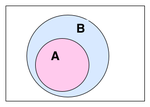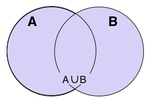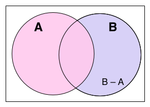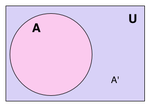Set (mathematics)
- This article is about sets in mathematics. For other meanings, see Set (disambiguation).
This template must be substituted. Replace {{Requested move ...}} with {{subst:Requested move ...}}. Set (mathematics). Please see talk page.
The notion of a set is one of the most important and fundamental concepts in modern mathematics. Basic set theory, having only been invented at the end of the 19th century, is now a ubiquitous part of mathematics education, being introduced as early as elementary school. This article gives a brief and basic introduction to what mathematicians call "intuitive" or "naive" set theory; for a more detailed account see Naive set theory. For a rigorous axiomatic treatment of sets see Axiomatic set theory.
Introduction
Informally, a set is just a well-defined collection of objects considered as a whole. The objects of a set are called elements or members. The elements of a set can be anything: numbers, people, letters of the alphabet, other sets, and so on. Sets are conventionally denoted with capital letters, A, B, C, etc. Two sets A and B are said to be equal, written A = B, if they have the same members.
The informality of this 'definition' of a set leaves clear that different sets are different; so the definition of a set goes hand in hand with a classification of its objects. Of course, sets share properties; but these properties are tightly connected with provisions in the definition of any given set. For example, we can't speak of combinatorics (see "cardinality" below) of uncountable sets, like the set of real numbers.
Describing sets
Descriptions using words or lists
A set may be described in words, for example:
- A is the set whose members are the first four positive whole numbers.
- B is the set whose members are the colors of the French flag.
By convention, a set can also be defined by explicitly listing its elements between braces (sometimes called curly brackets), for example:
- C = {4, 2, 1, 3}
- D = {red, white, blue}
Notice that two different descriptions may define the same set. For example, for the sets defined above, A and C are identical, since they have precisely the same members. The shorthand A = C is used to express this equality. Similarly, for the sets defined above, B = D.
Set identity does not depend on the order in which the elements are listed, nor on whether there are repetitions in the list. For example, {6, 11} = {11, 6} = {11, 11, 6, 11}.
Descriptions using mathematical notation
For large sets (that is to say, sets in which there are many elements), it becomes highly impractical to explicitly write out the full list of contents. For example, E = {the first one thousand positive whole numbers} would, as a list, be as tedious to write as it would be to read. However, a mathematician would seldom describe E in words as above, preferring instead to use a symbolic shorthand:
- E = {1, 2, 3, ..., 1000}
An abbreviated list can be used to describe a set such as E, where the elements can follow a pattern that is obvious to the reader. The full list is abbreviated using the ellipsis (...) symbol.
If, on the other hand, the characterizing property describes a less obvious pattern, then it is ill-advised to use an abbreviated list, which could serve to confuse the reader. For example, upon reading
- F = {–4, –3, 0, ..., 357}
it is unclear that
- F = {the first twenty numbers which are four less than a square number}.
In such circumstances, mathematicians describe the characterizing property of the set using mathematical notation. For example:
- F = { – 4 : n is a whole number and 0 n 19}
In this description, the colon (:) means such that, and the mathematician interprets this description as
- F is the set of numbers of the form – 4, such that n is a whole number in the range from 0 to 19 inclusive.
An explicit list of the contents of F can be found by evaluating the expression – 4 for each value of n from 0 to 19.
For more information on describing sets see Set-builder notation.
Set membership
If something is or is not an element of a particular set then this is symbolised by ∈ and respectively. So, for example:
- and (since 285 = 17² − 4); but
- and .
Cardinality of a set
Each of the sets described above has a definite number of members; for example, the set A has four members, while the set B has three members.
A set can also have zero members. Such a set is called the empty set (or the null set) and is denoted by the symbol ∅. For example, the set A of all living dragons has zero members, and thus A = ∅. Like the number zero, though seemingly trivial, the empty set turns out to be quite important in mathematics.
For more information on the empty set see Empty set.
A set can also have an infinite number of members; for example, the set of natural numbers is infinite.
For more information on infinity and the size of sets, see cardinality and cardinal number.
The science which concerns counting sets is called combinatorics. Easily the most famous combinatorial formulae are the permutations and combinations formulae.
Subsets
If every member of the set A is also a member of the set B, then A is said to be a subset of B, written A ⊆ B, or equivalently B ⊇ A, which can be read as B is a superset of A, B includes A or B contains A. The relationship between sets established by ⊆ is called inclusion or containment.
If A is a subset of but not equal to B, then A is called a proper subset of B, written A ⊂ B.
Examples:
- The set of all men is a proper subset of the set of all people.
The empty set is a subset of every set and every set is a subset of itself:
- ∅ ⊆ A
- A ⊆ A
For more information about subsets, see Subset.
Special sets
There are some sets which hold great mathematical importance and are referred to with such regularity that they have acquired special names to identify them. One of these is the empty set. Some special sets of numbers include:
- denotes the set of all natural numbers. That is to say, = {1, 2, 3, ...}.
- denotes the set of all integers (whether positive, negative or zero). So = {..., -2, -1, 0, 1, 2, ...}.
- denotes the set of all rational numbers (that is, the set of all proper and improper fractions). So, = { : a,b and b ≠ 0}. For example, and . All integers are in this set since every integer a can be expressed as the fraction .
- is the set of all real numbers. This set includes all rational numbers, together with all irrational numbers (that is, numbers which can't be rewritten as fractions, such as – and √2).
- is the set of all complex numbers.
Each of these sets of numbers has infinite cardinality, and moreover .
Unions
There are several ways to construct new sets from existing ones. Two sets can be "added" together. The union of A and B, denoted by A ∪ B, is the set of all things which are members of either A or B.
Examples:
- {1, 2} ∪ {red, white} = {1, 2, red, white}
- {1, 2, green} ∪ {red, white, green} = {1, 2, red, white, green}
- {1, 2} ∪ {1, 2} = {1, 2}
Some basic properties of unions:
- A ∪ B = B ∪ A
- A ⊆ A ∪ B
- A ∪ A = A
- A ∪ ∅ = A
For more information about unions of sets, see Union (set theory).
Intersections
A new set can also be constructed by determining which members two sets have "in common". The intersection of A and B, denoted by A ∩ B, is the set of all things which are members of both A and B. If A ∩ B = ∅, then A and B are said to be disjoint.
Examples:
- {1, 2} ∩ {red, white} = ∅
- {1, 2, green} ∩ {red, white, green} = {green}
- {1, 2} ∩ {1, 2} = {1, 2}
Some basic properties of intersections:
- A ∩ B = B ∩ A
- A ∩ B ⊆ A
- A ∩ A = A
- A ∩ ∅ = ∅
For more information about intersections of sets, see Intersection (set theory).
Complements
Two sets can also be "subtracted". The relative complement of A in B (also called the set theoretic difference of B and A), denoted by B − A, is the set of all elements which are members of B, but not members of A.
In certain settings all sets under discussion are considered to be subsets of a given universal set U. In such cases, U − A, is called the absolute complement or simply complement of A, and is denoted by A′.
Examples:
- {1, 2} − {red, white} = {1, 2}
- {1, 2, green} − {red, white, green} = {1, 2}
- {1, 2} − {1, 2} = ∅
- If U is the set of integers, E is the set of even integers, and O is the set of odd integers, then the complement of E is O, or equivalently, E′ = O.
Some basic properties of complements:
- A ∪ A′ = U
- A ∩ A′ = ∅
- (A′ )′ = A
- A − A = ∅
- A − B = A ∩ B′
For more information about complements of sets, see Complement (set theory).
Further reading
For more information on the basic properties of sets, subsets, intersections, unions and complements, see The algebra of sets. For a more general development of these ideas and others in set theory, see Naive set theory.
References
- Halmos, Paul R., Naive Set Theory, Princeton, N.J.: Van Nostrand (1960) ISBN 0387900926
- Stoll, Robert R., Set Theory and Logic, Mineola, N.Y.: Dover Publications (1979) ISBN 0486638294


























